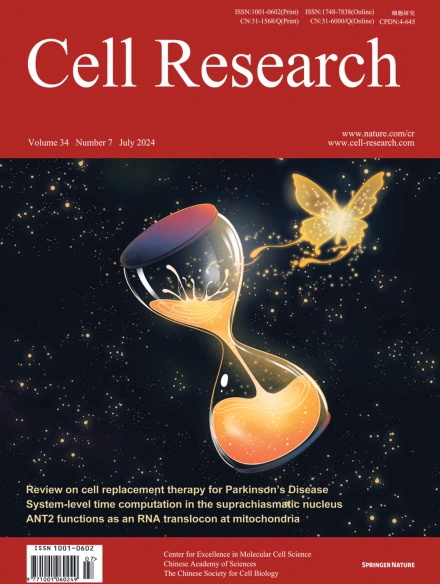
Advanced Search
Submit Manuscript
Advanced Search
Submit Manuscript
Volume 34, No 7, Jul 2024
ISSN: 1001-0602
EISSN: 1748-7838 2018
impact factor 17.848*
(Clarivate Analytics, 2019)
Volume 34 Issue 7, July 2024: 504-521
ANT2 functions as a translocon for mitochondrial cross-membrane translocation of RNAs
Pengcheng Wang1 , Lixiao Zhang1 , Siyi Chen1 , Renjian Li1 , Peipei Liu2 , Xiang Li1 , Hongdi Luo1 , Yujia Huo1 , Zhirong Zhang1 , Yiqi Cai1 , Xu Liu1 , Jinliang Huang2 , Guangkeng Zhou1 , Zhe Sun1 , Shanwei Ding1 , Jiahao Shi1 , Zizhuo Zhou1 , Ruoxi Yuan1 , Liang Liu1 , Sipeng Wu1,* , Geng Wang1,*
1State Key Laboratory for Cellular Stress Biology, Innovation Center for Cell Signaling Network, School of Life Sciences, Xiamen University, Fujian, ChinaBidirectional transcription of mammalian mitochondrial DNA generates overlapping transcripts that are capable of forming double-stranded RNA (dsRNA) structures. Release of mitochondrial dsRNA into the cytosol activates the dsRNA-sensing immune signaling, which is a defense mechanism against microbial and viral attack and possibly cancer, but could cause autoimmune diseases when unchecked. A better understanding of the process is vital in therapeutic application of this defense mechanism and treatment of cognate human diseases. In addition to exporting dsRNAs, mitochondria also export and import a variety of non-coding RNAs. However, little is known about how these RNAs are transported across mitochondrial membranes. Here we provide direct evidence showing that adenine nucleotide translocase-2 (ANT2) functions as a mammalian RNA translocon in the mitochondrial inner membrane, independent of its ADP/ATP translocase activity. We also show that mitochondrial dsRNA efflux through ANT2 triggers innate immunity. Inhibiting this process alleviates inflammation in vivo, providing a potential therapeutic approach for treating autoimmune diseases.
https://doi.org/10.1038/s41422-024-00978-5